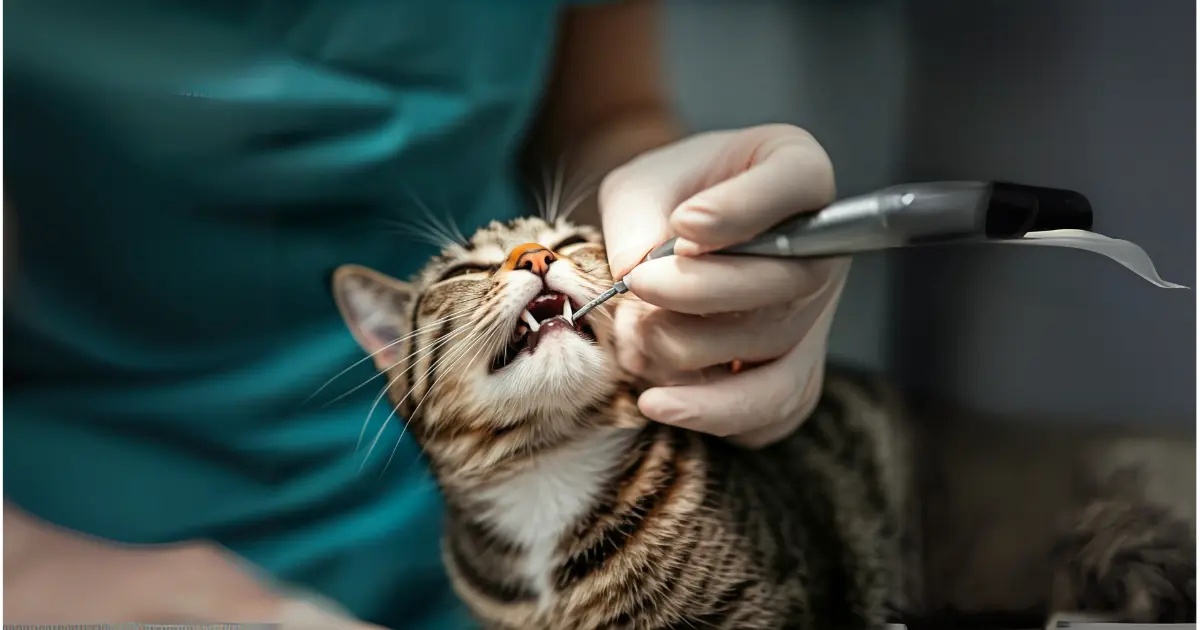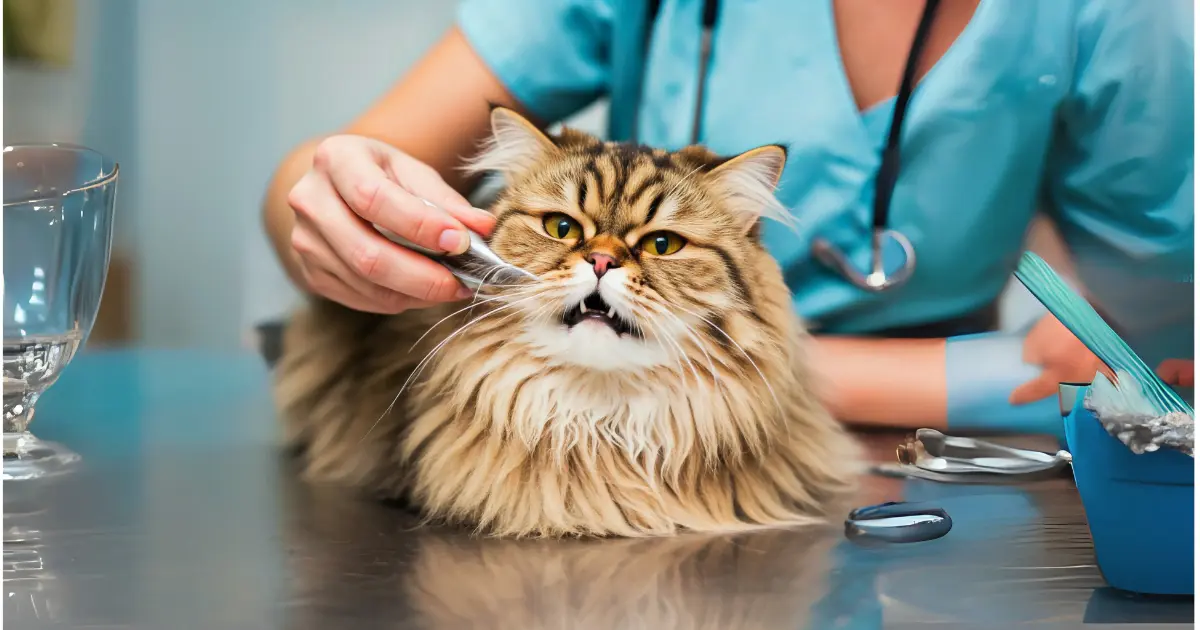“How to Clean Cat Teeth: Essential Tips for a Healthy Smile”
Published: 7 Jan 2025
As a responsible pet owner, maintaining your cat’s dental health is as essential as providing proper nutrition and regular vet visits. Like humans, cats are prone to dental issues such as tartar buildup, gum disease, and even tooth loss if their teeth aren’t correctly cared for. But how can you ensure your feline’s teeth stay clean and healthy without turning your home into a battleground?

Let’s walk through everything you need to know about how to clean cat teeth naturally, how long to brush cat teeth, and much more!
1. How to Clean Your Cat’s Teeth Naturally
For many cat owners, brushing their cat’s teeth may seem daunting. However, there are several natural ways to clean cat teeth without toothpaste or brushes. Here are a few options that can help keep your cat’s teeth in great shape:
Raw Diets: Some pet owners feed their cats raw, meaty bones (always supervised), which naturally help scrape plaque and tartar from teeth. However, be cautious with this approach, as not all raw bones are safe.
Dental Chews and Treats: Numerous dental treats are available for cats that help reduce plaque buildup while they chew.
Water Additives: Dental health water additives can be mixed into your cat’s drinking water, helping to reduce plaque and tartar formation without brushing.
Dental Sprays or Gels: If brushing is not an option, you can use dental sprays or gels that help break down plaque and freshen breath.
“Feeding your cat a balanced, nutritious diet is just as important for their dental health as regular brushing. Cat nutrition plays a significant role in preventing plaque buildup and ensuring strong teeth and gums.”

2. How Long to Brush Your Cat’s Teeth For?
Brushing your cat’s teeth is one of the most effective ways to prevent dental disease. You should strive to brush your cat’s teeth every day. However, if daily brushing isn’t possible, brushing at least two to three times per week is the next best option.
Each brushing session should last about 1 to 2 minutes, focusing on all the teeth, especially the back molars, where plaque accumulates most.
3. How to Clean Your Senior Cat’s Teeth
As cats age, They become more prone to dental problems such as periodontal disease, tooth resorption, and tartar buildup. If you’re wondering how to clean an old cat’s teeth, here are some tips tailored for senior cats:
- Gentle Brushing: Older cats may have more sensitive gums, so using a softer toothbrush and being gentle while brushing is essential.
- Frequent Vet Check-ups: Older cats should have regular dental check-ups, which are vital to detect any early signs of issues, as they may not tolerate advanced dental procedures as easily.
- Hydration and Soft Food: Encouraging your senior cat to drink water and offering soft food will reduce the strain on their teeth.
4. How to Clean Your Cat’s Back Teeth
The back teeth (molars and premolars) are especially prone to plaque buildup and are harder to reach. Here’s how to ensure these teeth stay clean:
- Use a Long-handled Toothbrush: A more extended handle can help you reach your cat’s back teeth more effectively.
- Dental Gel or Spray: Besides brushing, you can apply a dental gel or spray specifically designed for cats. These can help loosen plaque, especially on the back molars.
Focus on the Upper and Lower Molars: Spend extra time cleaning the upper and lower molars, as these teeth accumulate tartar the fastest.
“For long-haired cats, brushing their teeth is just as important as brushing their fur. Their dense coats require extra care, and ensuring they have healthy teeth will make your grooming sessions more effective and comfortable for them.”
5. Best Way to Clean Cat’s Teeth Without Brushing
If your cat refuses to allow brushing, many alternatives remain to keep their teeth clean and healthy. Here are some great options for how to clean a cat’s teeth without brushing:
- Dental Treats: Special treats designed to clean your cat’s teeth as it chews are available. Choose products with the Veterinary Oral Health Council (VOHC) seal of approval.
- Chew Toys: Rubber or rubberized dental toys can help massage your cat’s gums while scraping away plaque.
- Dental Diets: Some cat foods are specially formulated to help reduce tartar buildup. These can significantly add to your cat’s overall dental care routine.
6. How to Remove Cat Bucket Teeth (Damaged or Problematic Teeth)
Despite our best efforts, cats sometimes develop problems like broken or diseased teeth. “Bucket teeth” might refer to severely damaged or loose teeth. If your cat has a broken or damaged tooth, here’s what you can do:
- Schedule a Vet Visit: If you suspect your cat has damaged or problematic teeth, such as “bucket teeth,” it’s crucial to get them checked by a vet as soon as possible. Depending on the severity of the issue, your vet may suggest extraction or a root canal.
- Pain Relief: Cats with damaged teeth often experience pain. Speak with your vet about appropriate pain relief options to ensure your cat is comfortable.

7. How to Brush Your Cat’s Back Teeth
The back teeth of cats (especially molars and premolars) can be challenging to brush, but cleaning them correctly is crucial to prevent tartar and plaque buildup. Here’s how to brush a cat’s back teeth effectively:
- Use a Long Toothbrush or Finger Brush: A toothbrush with a long handle can make reaching the back of your cat’s mouth easier. Alternatively, finger brushes may offer better control.
- Be Gentle. The back teeth may have more plaque, so gently work the brush in small circles. If your cat isn’t used to brushing the back teeth, you may need to work up to it.
8. How to Clean Extracted Cat Teeth
Proper care is necessary to ensure healing after a cat undergoes a tooth extraction. If your cat has had a tooth removed, here’s how to clean extracted cat teeth and maintain their oral health afterward:
- Follow Vet Instructions: Your vet will provide specific aftercare instructions. These may include recommendations on how to clean the gums, what food to give your cat, and how to monitor for infection.
- Soft Food: After an extraction, your cat may find it easier to eat soft food, which will not irritate the gums and healing area.
- Monitor for Infections: Monitor the healing process. Discuss this with your vet if you notice swelling or discharge at the extraction site.
9. How to Clean Teeth for Cats
Overall, cleaning your cat’s teeth involves a combination of regular brushing, appropriate dental products, and routine vet visits. To clean the teeth of cats, follow these steps:
- Regular Brushing: Make brushing a habit, ideally every day or at least a few times a week.
- Use Cat-Specific Products: Always use products specifically for cats, such as cat-safe toothpaste and toothbrushes.
- Check for Problems: If you notice any unusual behavior, like reluctance to eat, drooling, or bad breath, it may indicate dental problems.
10. How to Keep Your Cat’s Teeth Clean and Healthy
Prevention is always the best strategy when it comes to dental care. Here’s how to keep your cat’s teeth clean and healthy over the long term:
- Routine Brushing: Brush your cat’s teeth at least a few times weekly.
- Regular vet check-ups are vital for detecting early signs of dental issues and maintaining your cat’s oral health. Learn more about feline dental care at PetMD’s Cat Dental Health Guide.
- Dental Chews and Treats: Incorporate dental treats into their diet for extra support.
- Fresh Water: Make sure your cat always has access to clean water, which helps keep their mouth hydrated and reduces plaque buildup.
- “If you’re traveling with your cat in the car, ensure their oral health remains a priority. A comfortable cat is a happy cat, and dental health can significantly ensure your cat remains stress-free during trips.”
Conclusion
Keeping your cat’s teeth clean doesn’t have to be a chore! Whether you brush your teeth regularly, use natural cleaning methods, or explore alternatives like dental treats and chew toys, the key to success is consistency. If you’re unsure about the best methods for your cat, consult your vet for personalized advice tailored to your feline friend’s needs.
Remember, a healthy smile means a happy cat!
FAQs
Ideally, you should brush your cat’s teeth every day, but at least two to three times a week is also effective.
No, human toothpaste contains ingredients that are harmful to cats, so always use toothpaste made specifically for cats.
Dental treats are specially designed to help clean your cat’s teeth by reducing plaque buildup as they chew.
It’s best to use a toothbrush designed for cats, which has softer bristles and is the right size for their mouth.
Signs of dental problems include bad breath, difficulty eating, drooling, or pawing at their mouth.

- Be Respectful
- Stay Relevant
- Stay Positive
- True Feedback
- Encourage Discussion
- Avoid Spamming
- No Fake News
- Don't Copy-Paste
- No Personal Attacks



- Be Respectful
- Stay Relevant
- Stay Positive
- True Feedback
- Encourage Discussion
- Avoid Spamming
- No Fake News
- Don't Copy-Paste
- No Personal Attacks





